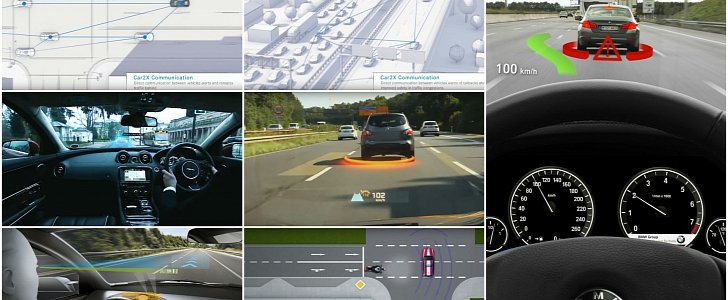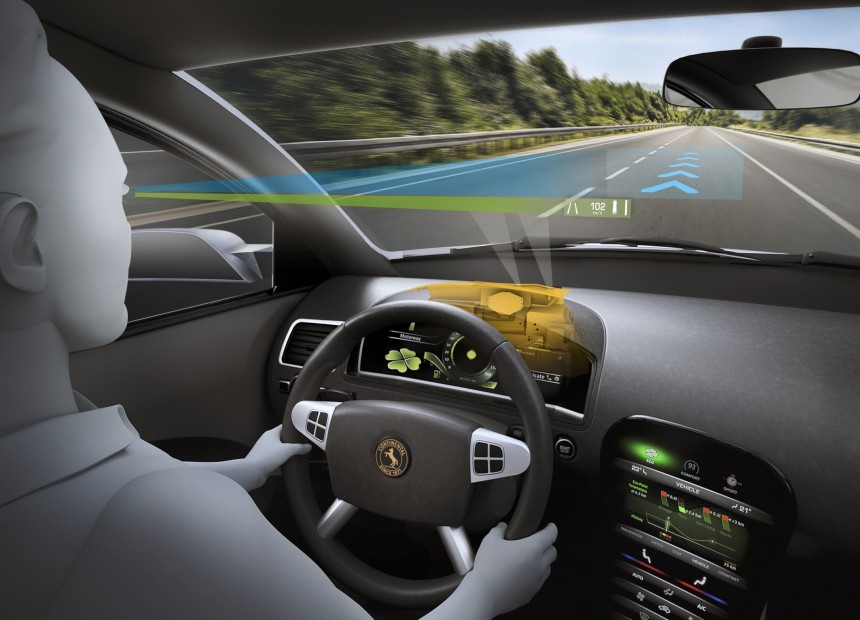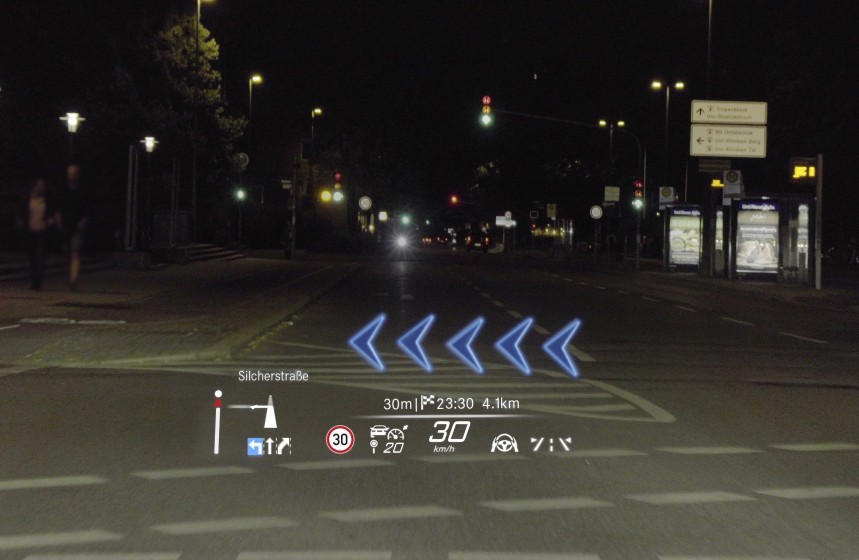A time traveler from as late as the 1980s would probably be a bit flabbergasted if he were in the position to experience a modern car in recent times. Sure, there aren't that many technical differences between a current Mercedes-Benz C-Class, which is soon to be replaced, and a Mercedes-Benz 190, but when it comes to safety and comfort features, they are as different as birds and bats.
The only high-tech safety systems you can find on a 190 (W201) are seatbelt pre-tensioners, a collapsible steering column, crumple zones, an optional ABS system and a front driver airbag (on later models). Part of the active safety features on a C-Class (W205) involve ESP, Pre-Safe, Distronic Plus with Pre-Safe Brake, Attention Assist, Active Blind Spot and Active Lane Keeping Assist, Intelligent LED headlights and many, many, more.
Technology overall has evolved exponentially in recent years, but that doesn't mean it has stopped in 2015. On the contrary, the stuff of Sci-Fi movies will soon be upon us, most of the upcoming car safety systems sounding almost like alien technology even for millennials. When acting together, they will likely change the act of driving as we know it.
There is even a Car 2 Car Consortium, which Mercedes-Benz, BMW, Audi, GM, Honda, and Volvo are already part of, and it should make it easier for regulators and carmakers to implement a global standard. This means that in the future, no matter what brand of car you drive, your vehicle will be able to communicate wirelessly with any other car, and even with certain parts of the infrastructure.
The cars could exchange information about the local speed limits and current road conditions in any area. The possibilities are almost endless once the infrastructure also adapts to the technology, since a traffic light that is about to turn red or green will be able to alert oncoming cars about the change so that drivers can either accelerate or start braking well before they see the intersection.
This will help reduce accidents and also improve the flow of traffic. Emergency vehicles will be able to give a heads-up without using their sirens in busy areas, so that other cars can get out of their way in due time. Information regarding impromptu road-works, accidents, traffic jams and even local weather changes can be transmitted between cars and, therefore, avoided in time. Driving in the near future will certainly be less stressful.
Organized by the International Telecommunication Union (ITU), the United Nations' agency for information and communication, it signaled once again that an accident-free future and fully-efficient public transportation is just around the corner. And It's all thanks to the rapid evolution in terms of car safety technologies.
In fact, depending on how legislation evolves, by 2025 we may already have autonomous taxis, with companies like Uber being prime candidates for its implementation. Used especially in large cities, the networking of public transportation with other vehicles and with the surrounding infrastructure will reduce congestion and emissions, drastically improve road safety and increase the mobility of the elderly and/or persons with disabilities at the same time.
Normally, “more complicated” would translate into even more distractions for the driver, but this shouldn't be the case if HUDs evolve on the right path. The so-called “super multi-view head-up display” will incorporate details like an augmented reality display on the windshield, while the front passenger will have his own view of entirely different characteristics.
Instead of watching a 2D display that only shows basic information, the driver will be able to see street names written in 3D across nearby buildings or into the distance, hovering above the landscape. The implementation of augmented reality will even allow you to drive in zero-visibility conditions (fog, rain or snow), since an onboard computer will recreate most of the surroundings and the HUD will project them in real time across the windshield.
The computer will get the necessary info from laser and radar sensors all around the car, cross-referencing it with 3D maps of the surrounding area. It sounds scary and a bit far-fetched, but we're already on the way to getting there. Just have a look at the augmented reality HUD in the recently unveiled Mercedes-Benz S-Class W223.
A team of Japanese scientists from the Institute of Engineering in Tokyo and another one from Denso's Research Laboratories have already had major breakthroughs in this area as early as 2011. Their idea involves a so-called “smooth motion parallax,” which means that the 3D HUD will not need special glasses and the driver won't need to adjust his eyes in order to see the info across the windshield without experiencing headaches and blurred vision.
The rapid advancement in research and development is gradually following a steeper curve, which means that it will become increasingly more difficult to predict when some of the technologies above will be implemented on a large scale. What we do know is that the world is changing rapidly, and a niche research area like automotive safety systems will be able to transform more than our driving habits: it may change our very own existence.
Technology overall has evolved exponentially in recent years, but that doesn't mean it has stopped in 2015. On the contrary, the stuff of Sci-Fi movies will soon be upon us, most of the upcoming car safety systems sounding almost like alien technology even for millennials. When acting together, they will likely change the act of driving as we know it.
Car-to-X Communication
In essence, this future system will be the easiest to implement, especially since a lot of current and upcoming cars have built-in wireless Internet capabilities. As early as 2013, Mercedes-Benz integrated a Car-to-X communication system on some of its models, but it was obviously an antique and much simpler version of what's to come in the next few years.There is even a Car 2 Car Consortium, which Mercedes-Benz, BMW, Audi, GM, Honda, and Volvo are already part of, and it should make it easier for regulators and carmakers to implement a global standard. This means that in the future, no matter what brand of car you drive, your vehicle will be able to communicate wirelessly with any other car, and even with certain parts of the infrastructure.
This will help reduce accidents and also improve the flow of traffic. Emergency vehicles will be able to give a heads-up without using their sirens in busy areas, so that other cars can get out of their way in due time. Information regarding impromptu road-works, accidents, traffic jams and even local weather changes can be transmitted between cars and, therefore, avoided in time. Driving in the near future will certainly be less stressful.
Networked cars with autonomous capabilities
Closely related to Car-To-X communication, networked cars with autonomous capabilities will probably change the entire idea of public transport. Wait, not change it; make that take it to the backyard and shoot it. Two years ago marked the 13th edition of the Future Networked Car symposium at the Geneva Motor Show.Organized by the International Telecommunication Union (ITU), the United Nations' agency for information and communication, it signaled once again that an accident-free future and fully-efficient public transportation is just around the corner. And It's all thanks to the rapid evolution in terms of car safety technologies.
In fact, depending on how legislation evolves, by 2025 we may already have autonomous taxis, with companies like Uber being prime candidates for its implementation. Used especially in large cities, the networking of public transportation with other vehicles and with the surrounding infrastructure will reduce congestion and emissions, drastically improve road safety and increase the mobility of the elderly and/or persons with disabilities at the same time.
Super Multi-View Head-up Display
I know, we already have head-up display systems in cars, some of them even color and filled with helpful information like current vehicle speed, turn-by-turn navigation arrows or local speed warnings. Despite being criticized by some, at least in their current form, the fighter jet-inspired technology is about to get a whole lot more complicated in a few years.Normally, “more complicated” would translate into even more distractions for the driver, but this shouldn't be the case if HUDs evolve on the right path. The so-called “super multi-view head-up display” will incorporate details like an augmented reality display on the windshield, while the front passenger will have his own view of entirely different characteristics.
Instead of watching a 2D display that only shows basic information, the driver will be able to see street names written in 3D across nearby buildings or into the distance, hovering above the landscape. The implementation of augmented reality will even allow you to drive in zero-visibility conditions (fog, rain or snow), since an onboard computer will recreate most of the surroundings and the HUD will project them in real time across the windshield.
A team of Japanese scientists from the Institute of Engineering in Tokyo and another one from Denso's Research Laboratories have already had major breakthroughs in this area as early as 2011. Their idea involves a so-called “smooth motion parallax,” which means that the 3D HUD will not need special glasses and the driver won't need to adjust his eyes in order to see the info across the windshield without experiencing headaches and blurred vision.
The rapid advancement in research and development is gradually following a steeper curve, which means that it will become increasingly more difficult to predict when some of the technologies above will be implemented on a large scale. What we do know is that the world is changing rapidly, and a niche research area like automotive safety systems will be able to transform more than our driving habits: it may change our very own existence.











